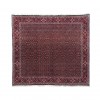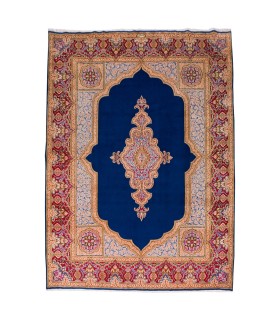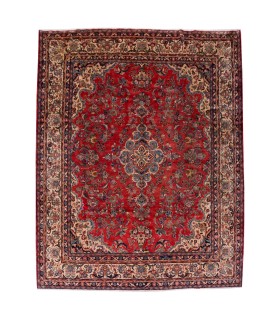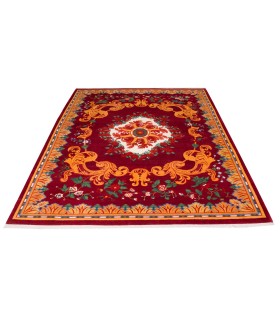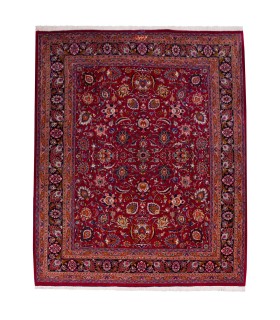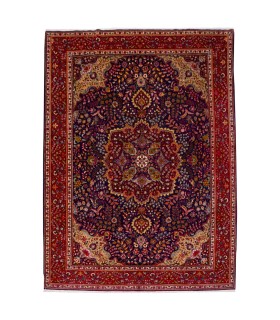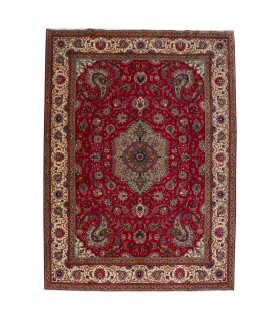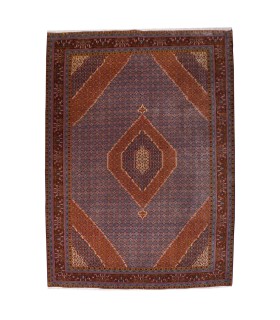This beautiful carpet is Bijar Afshar. Afshar is a handwoven rug style produced by the Turkic Afshar tribe, a semi-nomadic group principally located in the mountainous areas surrounding the modern region of Iranian Azerbaijan. An additional population of Afshar tribes-people is located in the Kuchan area in Razavi Khorasan Province of Iran and city of Kerman. Carpets in the Afshar style are known for their striking and stylized floral geometric designs, sophisticated tribal artistry and a characteristic palette of rust and blue color tones.
Herati pattern is a very common repeat field design consisting of a flower centered in a diamond with curving lancolate leaves located outside the diamond and parallel to each side. There are many versions of this design in different shapes and dimensions. Some refer to this design as a fish design because of the resemblance of the inner shapes to a fish.
Dying method of material of this carpet was traditional and all dyes which used were natural dyes. Colors of natural dyes are softer and more natural looking and longer lasting than their synthetic counterparts. Sometimes natural dyes contribute to Abrash. Since all-natural dyes are not chemically or synthetically based or fixed, no two dye lots can ever be exactly the same.
Some examples of natural dyes are:
Plant Dyes: saffron, Isparuk, oak apples etc. for yellow colors; indigo for blue; madder roots (depending on age) for various red tones, as well as henna leaves and flowers, etc.
Animal Dyes: the most important of these is cochineal and in earlier times, Indian lac, both obtained from insects. A purple dye obtained from snails was Important in ancient times.
Mineral Dyes: Karaboja for black - also iron oxide; iron sulphate for brown; copper sulphate for green, etc.
In addition, however, colors will vary with the wool quality, e.g., its fat content, as well as with the chemical composition of the water which is used for preparing the dye baths.
As you can see in the photos, some colors of this carpet is Abrash. Abrash means the appearance of slight deviations within the same color (from Turkish abraş, literally, “speckled, piebald”). Abrash is seen in traditionally dyed oriental rugs. Its occurrence suggests that a single weaver has likely woven the carpet, who did not have enough time or resources to prepare a sufficient quantity of dyed yarn to complete the rug. Only small batches of wool were dyed from time to time. When one string of wool was used up, the weaver continued with the newly dyed batch. Because the exact hue of color is rarely met again when a new batch is dyed, the color of the pile changes when a new row of knots is woven in. As such, the color variation suggests a village or tribal woven rug, and is appreciated as a sign of quality and authenticity. In newer productions Abrashs are often made in order to give the rug a more authentic antique look.
Data sheet
- Type
- Town/Village
- Origin
- Bijar Afshar
- City
- Bijar
- Dimension (cm)
- 205 × 197 (6/73 × 6/46)
- Area (Square metre)
- 4.04
- Material
- Wool (Cotton Foundation)
- Dyes
- Natural / Vegetable dyes
- Layout
- All-Over
- Design
- Herati
- Border Color
- Red
- Approx. Pile Height (cm)
- Approx. 2 cm
- Shape
- Square
- Approx. Weight (kg)
- 16
- Note
- Bidjar Afshar


















